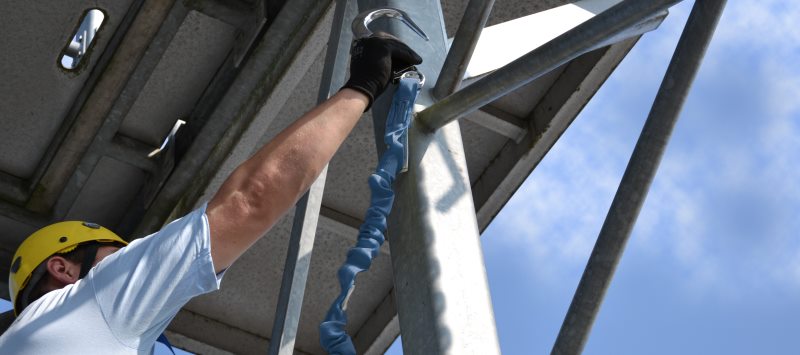
This is the third part of our blog series about Personal Protective Equipment (PPE) for fall protection and when PPE needs to be replaced. In the first blog, we described various factors that affect the strength and safety of a full body safety harness. After that, we focused on when an automatic fall arrest device needs to be thoroughly inspected by a competent person or even replaced by a new one.
Just as (intensive) use of safety harnesses and automatic fall arrest devices may affect their safety on the long term, another essential piece of PPE must also be checked properly before each use to make sure it’s safe to use: the lanyard.
Various types of lanyards
Lanyards come in different shapes and sizes, each with their own purpose. The most important distinction is that of lanyards for fall arrest and fall restraint.
Fall Arrest lanyards
As the name suggests, these lanyards are used in fall protection systems that are meant to arrest a fall, preventing the user to hit the ground or another obstacle below. These lanyards are standard equipped with a personal energy absorber to minimize the impact forces of a fall arrest to the human body. This helps preventing serious (internal) injuries.
Fall restraint lanyard
These lanyards are used for systems where users are protected from a fall by restricting their freedom of movement. These types of lanyards restrict the user of reaching the edge of a roof, dangerous skylights or other situations that can lead to a fall hazard.
When might a lanyard be unsafe to use?

First of all, a lanyard (just like all fall protection PPE) needs to be checked before each use. Minor damages or seemingly harmless abrasions/deformations may already affect the safety of a lanyard significantly. So it’s essential to spot them before you are going to use the lanyard.
What are the important indicators of an unsafe lanyard? We will outline some examples below and later on, we will provide a download-link to a poster that can be used as a guideline for a pre-use check of a lanyard.
An activated or damaged personal energy absorber
When a fall has occurred with a fall arrest lanyard, the personal energy absorber is activated. This device consists of folded webbing that is stitched together. It requires 3 kN to start tearing, so it will most likely only be activated when a fall is arrested.
Obviously, a lanyard that has been subject to a fall needs to be replaced. But, intensive use can also damage or (partly) activate the personal energy absorber. In that case, it also needs to be taken out of service and checked by a competent person whether it can still be used in a fall arrest solution.

Inspect
Hardware and hooks

Inspect
Rope or webbing

Inspect
Personal Energy Absorber
Cuts and abrasions
Other obvious and easy-to-spot factors that might compromise the safety of a lanyard are cuts and abrasions. When a lanyard is used in construction, for example, there is a big chance of scraping the lanyard along a sharp edge. This might result in cuts or abrasions in the lanyard, forming a risk factor. When a user falls with a damaged lanyard, the forces of the fall arrest may cause it to break, with all its consequences.
A sharp edge can actually damage or cut your lanyard when there is enough force involved. For example, when someone falls from an edge, with sharp corners a lanyard without sharp edge protection can be teared. That’s why there are specialized lanyards with sharp edge protection; these lanyards are tested for these kinds of situations.
Damage to the hardware
Lanyards are always equipped with hardware: for example karabiners, scaffold hooks, snap hooks or a rope grab for fall restraint purposes.
The weather, circumstances, as well as intensive use have their effects on the function and strength of the hardware. Always check whether the locking mechanism of the hardware is working properly.
Other signs that indicate that hardware needs to be replaced or for the least checked by an authorized person are rust formation, heavy pollution and deformations by a fall or other situations where large forces are applied to the hardware.
What to do when you doubt the safety of the lanyard
When you find something that might mean that the lanyard is not safe to use in your fall protection system, take it out of service immediately. This way you prevent that co-workers (accidentally and unintentionally) use an ‘unsafe’ lanyard.
A competent (and trained) person needs to inspect the lanyard and determine whether it is safe to use again or whether it has to be replaced.
Download our free pre-check poster
We have made a poster in which we provide guidelines in checking a lanyard for fall protection, explained by a visual representation of the various factors. You can use it to make workers aware of the pre-use check and make it easy for them what to look for during this check.
